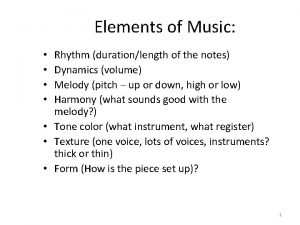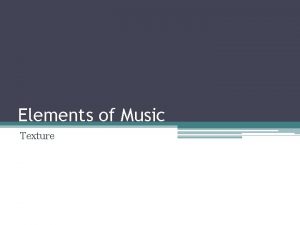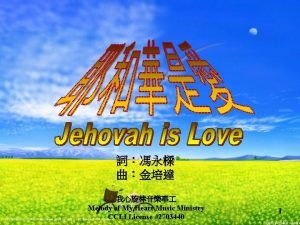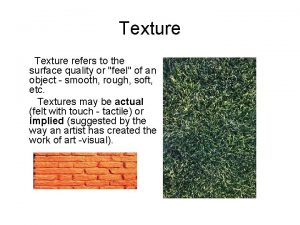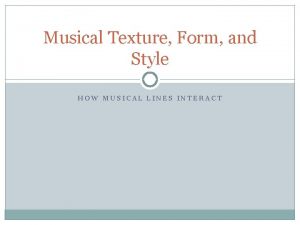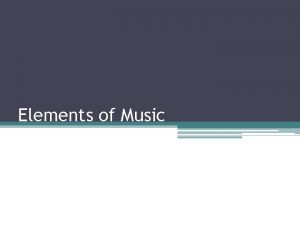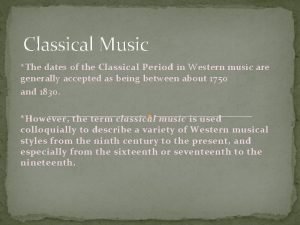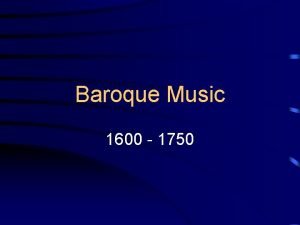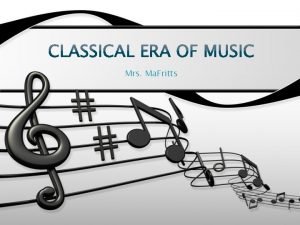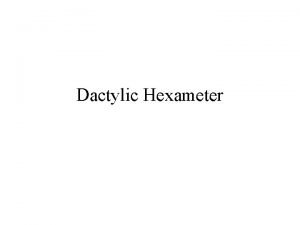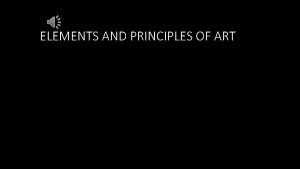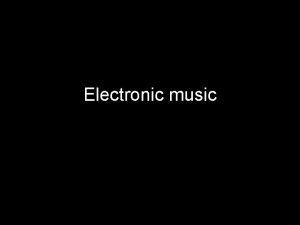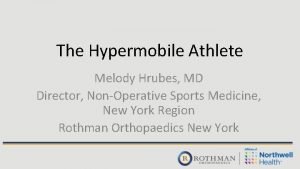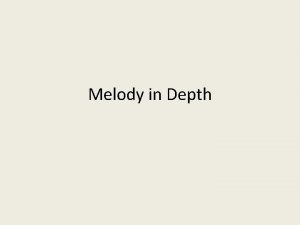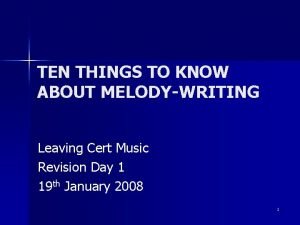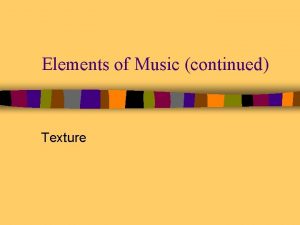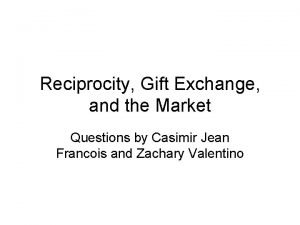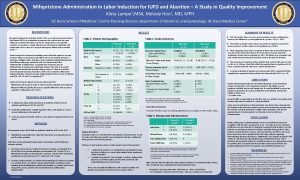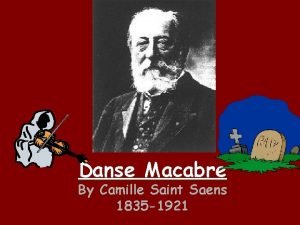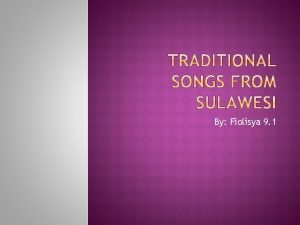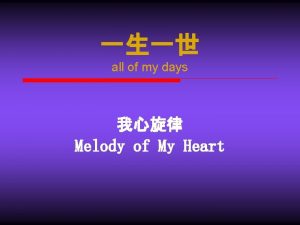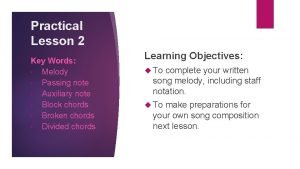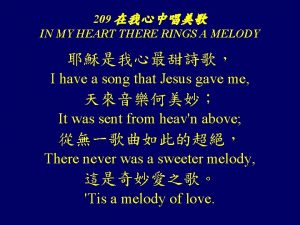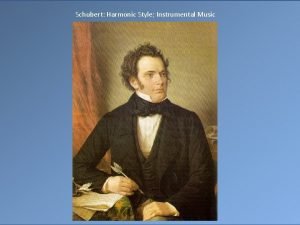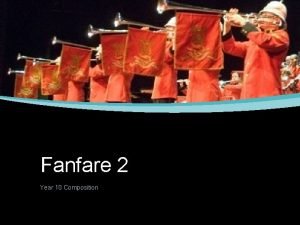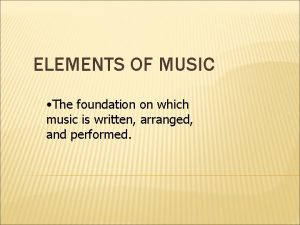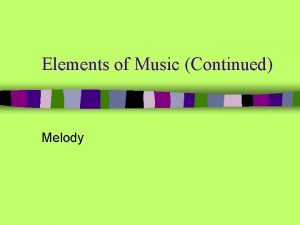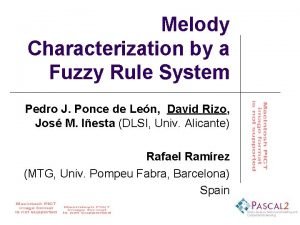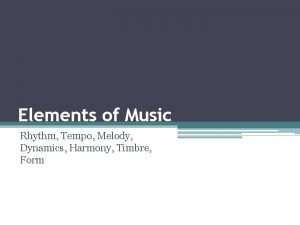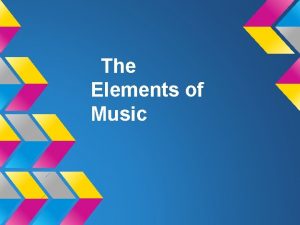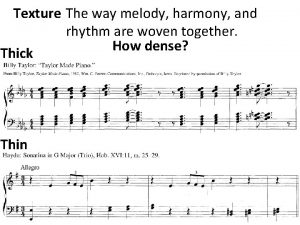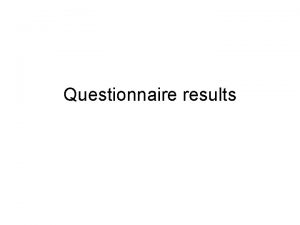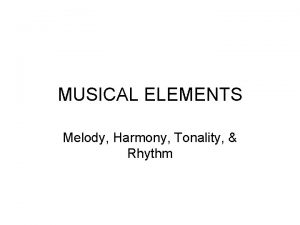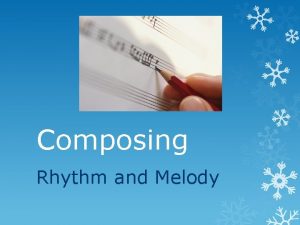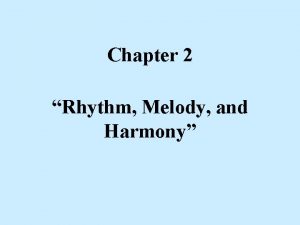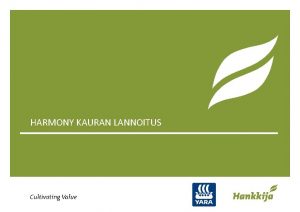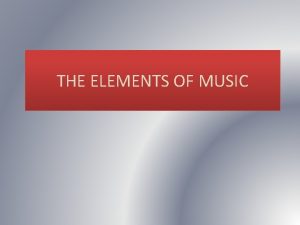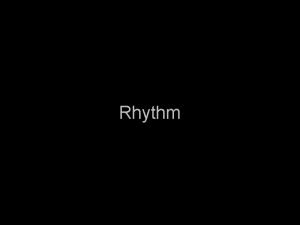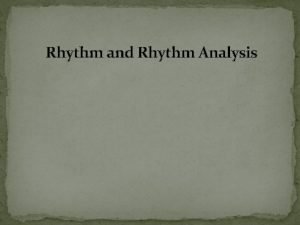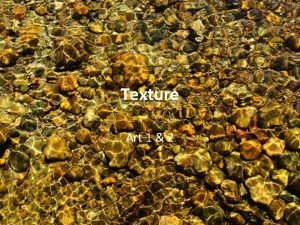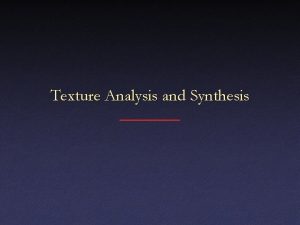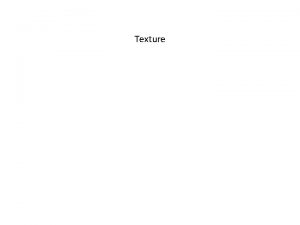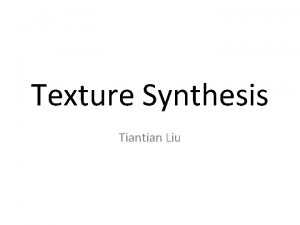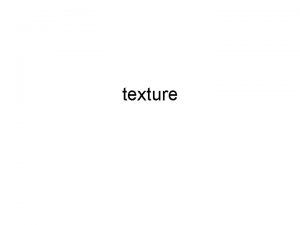The Elements of Music Melody Rhythm Harmony Texture










































- Slides: 42

The Elements of Music Melody Rhythm Harmony Texture Form Tempo and Dynamics

Melody: Musical Line • The Nature of Melody – Melody is a succession of single tones perceived by the mind as a unity – melody is the element with the widest and most appeal

Characteristics of Melody • Range – distance between highest and lowest notes – classified as wide, medium or narrow • Shape – determined by upward or downward direction of melody – graphed as ascending/descending line, arch or wave

Characteristics of Melody • Type of Movement – determined by whether melody moves by step or leap – conjunct - melody moves by step – disjunct - melody moves by leap

Structure of Melody • Melodic structure is analyzed much like a sentence – phrase - unit of meaning within a larger structure – cadence - end or resting place; may be inconclusive or final; like a comma or period

Structure of Melody • Combination of phrases with several inconclusive and one final cadence make up most music; like sentences in a paragraph

Rhythm: Musical Time • The Nature of Rhythm – Rhythm refers to the controlled movement of music in time – is the quality which causes people to move in response – automatically imposes a pattern to a series of noises, which are arranged as strong and weak beats

Meter • Meter is the fixed time patterns within which musical events take place – Rhythm is the overall movement of music in time while meter involves the actual measurement of time.

Meter • Characteristics of meter: – Beat - the basic unit of length; some beats are strong (accented) and some are weak (unaccented) – Measure - groups containing fixed beats with the first beat being the strongest

Metrical Patterns • Simple Meter - beat is subdivided into two beats – Duple - two beats per measure; strongweak; traditionally associated with marches – Triple - three beats per measure; strongweak-weak; associated with waltz (dance) form

Metrical Patterns • Simple Meter - beat is subdivided into two beats – Quadruple - four beats per measure; primary accent on one and secondary accent on three; has broader feel than duple; also called Common Time

Metrical Patterns • Compound Meter - beat is subdivided into three beats – Sextuple - Two beats per measure (six when subdivided); gentle and flowing when slow; rollicking feel when fast • Syncopation - deliberate upsetting of rhythm by temporary shifting of accent to weak beat or subdivided beat

Harmony: Musical Space • Harmony is the movement and relationship of intervals and chords, and implies movement and progression in music • Harmony gives perspective to music – melody is horizontal aspect and harmony is vertical aspect

Components of Harmony • Interval - distance and relationship between two tones • Scale - series of tones arranged in ascending or descending consecutive order – Octave - distance from highest to lowest tones in scale

Components of Harmony • Chord - combination of two or more tones that constitute a single block of harmony – Triad - combination of three tones utilizing every other tone of a scale; this is the basic formation of harmony

Function of Harmony • Harmony implies movement and progression in music – progression achieved by movement from one chord to another

Function of Harmony • Melody and Harmony are interdependent – melody implies the harmony to accompany – each constantly influences the other

Tonality • Harmony requires a system of procedures for organizing tones into intelligible relationships • Tonality - the principle of organization around a central tone, called tonic – tonic - first note of a scale which serves as base around which other tones revolve and to which they ultimately gravitate

Components of Tonality • The particular scale chosen as the basis of a piece of music determines the tonic and tonality of the music

Components of Tonality • Two types of scales are found in Western music between 1650 and 1900, and each is characterized in intervals on which they are based – Major - has brighter sound; used for triumphal marches and grand finales, etc. – Minor - has darker sound; used for dirges, laments, etc.

Components of Tonality • Diatonic vs. Chromatic – Diatonic - music based on one of the 12 major or minor scales – Chromatic - not based on a scale, but using all notes of the octave freely

Consonance and Dissonance • Consonance – a concordant or agreeable combination of tones that provides a sense of fulfillment in music – consonance is the resolution of dissonance

Consonance and Dissonance • Dissonance – a combination of tones that sounds discordant, unstable and in need of resolution – introduces a necessary tension in music • In general, music has grown more dissonant through the ages

Musical Texture • Types of Texture – Monophonic - single-voice texture; is a melody without accompaniment in the form of harmony – Polyphonic - combination of two or more melodic lines • Counterpoint - basis of polyphonic music; the technique of writing polyphony

Musical Texture • Types of Texture – Homophony - single melody with chordal accompaniment; sound is based on harmony – Heterophony - combination of two melodic lines based on improvisation; each line is the same melody, but at least one is improvised

Contrapunctal Devices • Imitation - subject or motive is presented in one voice and restated in another • Canon - imitation lasting for an entire work – Round - simplest form of canon; each voice enters in succession with the same melody

Contrapunctal Devices • Inversion - melody turned upside down; same intervals in opposite direction • Retrograde - restatement of melody backward; start at end and proceed to beginning – Retrograde Inversion - combination of techniques resulting in upside down and backward at the same time

Contrapunctal Devices • Augmentation - melody is presented in longer time values than original • Diminution - melody is presented in shorter time values than original

Musical Form • What is Form? – That quality in a work which presents to the mind of the listener an impression of conscious choice and arrangement – relationship of the parts to the whole

Structure and Design in Music • Repetition - fixes material in the mind; familiarity • Contrast - sustains interest by introducing change • Interaction of repetition and contrast is basic element of form

Structure and Design in Music • Variation - falls between repetition and contrast where aspects are altered but recognizable – Alterations generally focus on one element at a time

Types of Form • Binary Form - two part or A-B form; based on statement and departure without return to opening section • Ternary Form - three part or A-B-A form; based on statement, departure, and restatement of material • Both binary and ternary forms are common in short pieces such as songs and dances

Building Blocks of Form • Theme - most basic element of form which provides unity and from which the idea develops

Building Blocks of Form • Thematic Development - techniques for developing a theme – sequence - restatement of theme at new pitch level – repetition - exact of varied restatement of melody

Building Blocks of Form • Thematic Development - techniques for developing a theme – motive - smallest fragment of melody that forms rhythmic/melodic unit – movement - several separate pieces within a large scale work

Tempo and Dynamics • Tempo - speed at which beats occur within meter; close connection between tempo and mood • Dynamics - degree of loudness or softness at which music is played

Tempo and Dynamics • Markings for tempo and dynamics contribute to the expressive content of music • Early music had few markings, and usage has steadily increased throughout time

Examples of Tempo Indicators • • Grave………………. . Solemn Largo………………. . Broad Adagio……………… Slow Andante……………. . Walking Pace Moderato…………… Moderate Allegro……………… Fast Vivace……………… Lively Presto………………. Very Fast

Tempo Modifiers • • Molto………………. . Very Meno………………. . Less Poco………………… A Little Non Troppo………… Not Too Much

Changes of Tempo • Accelerando………… Getting Faster • Ritardando…………. . Getting Slower • A Tempo……………. Original Tempo

Principal Dynamic Indicators • • Pianissimo……. . Very Soft Piano…………. . . Soft Mezzo Piano … Moderately Soft Mezzo Forte…… Moderately Loud Forte…………… Loud Fortissimo……… Very Loud Use of dynamics is relative to size of ensemble

Changes of Dynamics • Crescendo…………. . Getting Louder • Decrescendo………. . Getting Softer • Sforzando…………. . Sudden Stress
 Elements of music
Elements of music Music texture definition
Music texture definition Music music music
Music music music Melody is the horizontal dimension in music
Melody is the horizontal dimension in music When a melodic idea is presented by one voice
When a melodic idea is presented by one voice Characteristics of vocal music
Characteristics of vocal music Melody of my heart music ministry
Melody of my heart music ministry Implied or simulated texture has tactile feel
Implied or simulated texture has tactile feel Loudness or quietness of music
Loudness or quietness of music Monophonic polyphonic homophonic
Monophonic polyphonic homophonic How to describe texture in music
How to describe texture in music Classical period started from 1750 to 1872
Classical period started from 1750 to 1872 The texture is lighter and clearer
The texture is lighter and clearer Unity of mood means what
Unity of mood means what Classical melodies are tuneful and easy to remember
Classical melodies are tuneful and easy to remember Dactylic rhythm
Dactylic rhythm Elements and principles of art
Elements and principles of art Classical vs romantic
Classical vs romantic What music that employs electronic music
What music that employs electronic music Texture of pamulinawen
Texture of pamulinawen Project melody ph
Project melody ph Melody hrubes md
Melody hrubes md Overall shape of a melody
Overall shape of a melody Generative adversarial networks
Generative adversarial networks Madtshirt meaning
Madtshirt meaning Counter melody
Counter melody Woo my love my darling
Woo my love my darling Melody writing leaving cert
Melody writing leaving cert Gf handel hallelujah chorus melody
Gf handel hallelujah chorus melody Melody maisin
Melody maisin Melody hou md mph
Melody hou md mph La danse macabre camille saint saëns
La danse macabre camille saint saëns Si patokaan lyrics english
Si patokaan lyrics english Lyrics in my heart there rings a melody
Lyrics in my heart there rings a melody Melody key words
Melody key words Wordle 209
Wordle 209 Gretchen am spinnrade melody
Gretchen am spinnrade melody Melody eide
Melody eide Additive melody
Additive melody 7 elements of music
7 elements of music Melody tô bem, tô zen
Melody tô bem, tô zen Wagner romanticism
Wagner romanticism Fuzzy melody set
Fuzzy melody set
